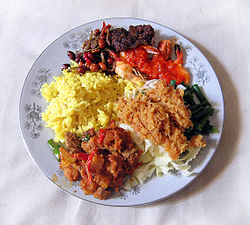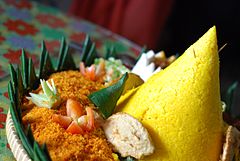Nasi kuning
 Nasi kuning personal serving, surrounded with rich Indonesian dishes | |
| Alternative names | Nasi kunyit |
|---|---|
| Course | Main course |
| Place of origin | Indonesia[1] |
| Region or state | Nationwide in Indonesia and Sri Lanka (known as kaha buth) |
| Created by | Javanese |
| Serving temperature | Hot and room temperature |
| Main ingredients | Rice cooked in turmeric surrounded with side dishes |

Nasi kuning (Indonesian for: "yellow rice"),[2] or sometimes called nasi kunyit (Indonesian for: "turmeric rice"), is an Indonesian fragrant rice dish cooked with coconut milk and turmeric,[3][4] hence the name nasi kuning (yellow rice).[1] It is also consumed in Sri Lanka where it is known as kaha buth and draws from both Indonesian and Sri Lankan influences.[5][6]
Cultural significance
In Indonesian culture, nasi kuning has favorable symbolic meanings. The yellow-colored rice is perceived to looks like a pile of gold,[7] so it is often served in festive occasions; including parties, housewarmings, welcoming guests and opening ceremonies — as a symbol of good fortune, prosperity, wealth and dignity.[8]
Nasi kuning is quite widespread and commonly found in Indonesian culture. It can be found from Java to Sumatra, Bali and Sulawesi. However, it is most strongly associated with Javanese and Minahasa traditions. In Java, nasi kuning might come in the form of a cone called a tumpeng and is usually eaten during special events.[9] The top of the tumpeng is customarily given to the most senior person in attendance. One of the most popular nasi kuning variant is came from Manado of North Sulawesi, which employs cakalang (skipjack tuna).[10]
Ingredients and serving
The addition of turmeric and coconut milk, sometimes also includes pandan and lemongrass during the rice cooking and steaming process, has contributed to a tempting colour, pleasant fragrance, soft texture and a flavourful taste of the yellow rice. Certain spices such as cinnamon, cardamom, cloves and bay leaves, might be added to enhance this aromatic fragrant rice dish.[11]
Nasi kuning is usually served with a variety of side dishes such as shredded omelette, serundeng (relish of grated coconut and spices), urap (vegetable in shredded coconut dressing), teri kacang (fried anchovy and peanuts), sambal goreng (fried tempeh and potato caramelized in spicy sauce), ayam goreng (Javanese-style fried chicken), balado udang (shrimp in chilli), or perkedel (potato fritters).[12] More elaborate nasi kuning might include fried cow's brain, fried cow's lung, beef and seafood. It is common to serve nasi kuning with kerupuk udang (shrimp cracker) or emping chips and a decoratively cut cucumber and tomato.
See also
- List of rice dishes
- Nasi bogana
- Nasi campur
- Nasi goreng
- Nasi kucing
- Nasi lemak
- Nasi liwet
- Nasi pecel
- Nasi tim
- Nasi uduk
- Nasi ulam
 Food portal
Food portal
References
- ^ a b Salloum, Habeeb (Dec 14, 2003). "Recipe: Nasi Kuning - Indonesian Yellow Rice | ThingsAsian". thingsasian.com. Retrieved 2018-01-24.
- ^ Holzen, Heinz Von (2014-09-15). A New Approach to Indonesian Cooking. Marshall Cavendish International Asia Pte Ltd. p. 51. ISBN 9789814634953.
- ^ Agostino, Helen; Kiting, Kathy (1999). Indonesia Kaleidoscope. Curriculum Corporation. ISBN 9781863663830.
- ^ Holzen, Heinz Von; Arsana, Lother (1999). The Food of Indonesia: Authentic Recipes from the Spice Islands. Periplus Editions. ISBN 9789625933894.
- ^ "Malay Dishes". YoungMelayu Sri Lanka.
- ^ Bullis, Douglas; Hutton, Wendy (2001). Food of Sri Lanka. Periplus. pp. 5, 14. ISBN 9625937609.
- ^ Roepers, Cyrus (2014-10-22). "Nasi Kuning: Indonesian Festive Rice". Arousing Appetites: Home to the Serious Cook. Retrieved 2018-01-25.
- ^ "Nasi Kuning Recipe (Indonesian Yellow Fragrant Rice)". Indonesia Eats.
- ^ Turner, T. (2015-10-27). Bali Travel Guide 2018: Must-see attractions, wonderful hotels, excellent restaurants, valuable tips and so much more!. T Turner.
- ^ Maya Safira (26 April 2016). "Nasi Kuning Manado yang Sedap dengan Pelengkap Ikan Cakalang". detikFood (in Indonesian).
- ^ "Nasi kuning (yellow rice)". www.taste.com.au. 2010-07-26. Retrieved 2018-01-25.
- ^ "Menyiapkan Lauk Tumpeng". detikfood (in Indonesian). Retrieved 2018-01-25.
